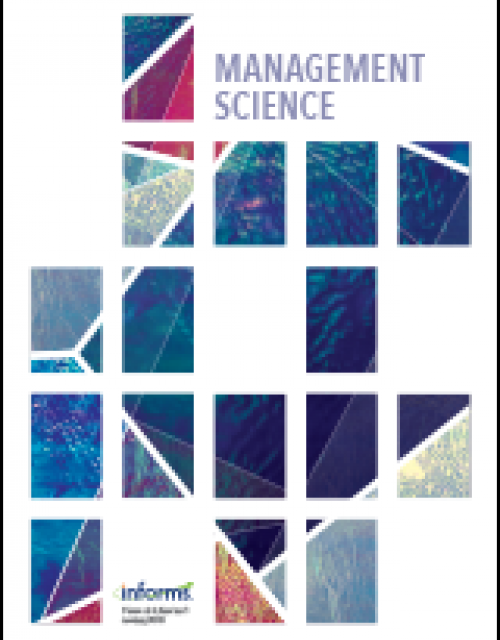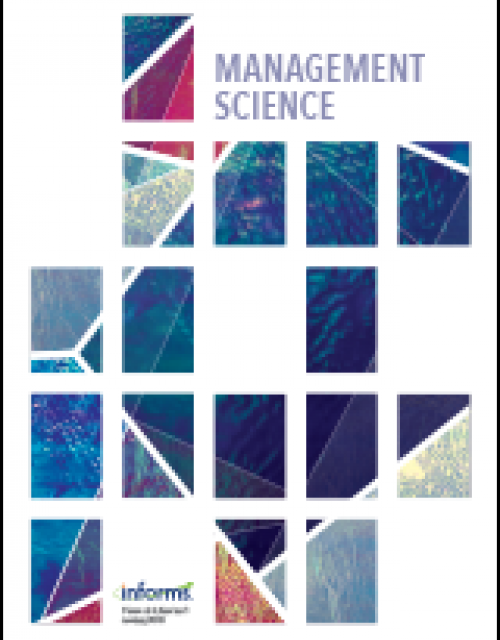Publication records
Subject(s)
Health and environment; Management sciences, decision sciences and quantitative methods
Keyword(s)
Information design, Bayesian persuasion game, dynamic programming, statistical decision, global health, disaster management
The World Health Organization seeks effective ways to alert its member states about global pandemics. Motivated by this challenge, we study a public agency’s problem of designing warning policies to mitigate potential disasters that occur with advance notice. The agency privately receives early information about recurring harmful events and issues warnings to induce an uninformed stakeholder to take preemptive actions. The agency’s decision to issue a warning critically depends on its reputation, which we define as the stake- holder’s belief regarding the accuracy of the agency’s information. The agency faces then a trade-off between eliciting a proper response today and maintaining its reputation in order to elicit responses to future events.
We formulate this problem as a dynamic Bayesian persuasion game, which we solve in closed form. We find that the agency sometimes strategically misrepresents its advance information about a current threat in order to cultivate its future reputation. When its reputation is sufficiently low, the agency downplays the risk and actually downplays more as its reputation improves. By contrast, when its reputation is high, the agency sometimes exaggerates the threat and exaggerates more as its reputation deteriorates. Only when its reputation is moderate does the agency send warning messages that fully disclose its private information.
Our study suggests a plausible and novel rationale for some of the false alarms or omissions observed in practice. We further test the robustness of our findings to imperfect advance information, disasters without advance notice, and heterogeneous receivers.
We formulate this problem as a dynamic Bayesian persuasion game, which we solve in closed form. We find that the agency sometimes strategically misrepresents its advance information about a current threat in order to cultivate its future reputation. When its reputation is sufficiently low, the agency downplays the risk and actually downplays more as its reputation improves. By contrast, when its reputation is high, the agency sometimes exaggerates the threat and exaggerates more as its reputation deteriorates. Only when its reputation is moderate does the agency send warning messages that fully disclose its private information.
Our study suggests a plausible and novel rationale for some of the false alarms or omissions observed in practice. We further test the robustness of our findings to imperfect advance information, disasters without advance notice, and heterogeneous receivers.
Copyright © 2020, INFORMS
Volume
66
Journal Pages
4359–4919
Subject(s)
Ethics and social responsibility
Keyword(s)
Impact valuation, impact assessment, corporate sustainability performance, Sustainable Business Value, SBV model
JEL Code(s)
M14
How can a company commit to maximizing stakeholder value while maintaining financial performance? Companies increasingly have the ambition to provide stakeholder value to their owners and shareholders, employees, consumers, suppliers, partners, the environment, and future generations. However, such companies often face difficulties in demonstrating the value they bring to stakeholders, due to the lack of universal methods for assessing their impact. Besides the practical need to develop a method for impact valuation, we researched the existing literature and discovered the lack of a holistic method to evaluate all impacts of a company using a common currency with flexible adaptations at different levels. We developed a new method called Sustainable Business Value (SBV) to address these gaps and enable companies to evaluate their impacts. We tested the SBV in two pilots. The SBV method differs from currently used methods, including sustainability reporting, sustainability rating and indices, and sustainability accounting. SBV can be used for decision-making, portfolio management, benchmarking, stakeholder communication, investor communication, and business development and also provides a comprehensive perspective of a company’s impact across six standardized dimensions. However, further development and standardization of proxies and cross-industry standards are needed.
Volume
12
Journal Pages
8420
ISSN (Online)
2071-1050
Subject(s)
Management sciences, decision sciences and quantitative methods
Keyword(s)
Service operations, rational inattention, strategic customers, rational queueing, information costs, system throughput, social welfare
Problem description: Classical models of queueing systems with rational and strategic customers assume queues to be either fully visible or invisible while service parameters are known with certainty. In practice, however, people only have “partial information” on the service environment in the sense that they are not able to fully discern prevalent uncertainties. This is because assessing possible delays and rewards is costly as it requires time, attention, and cognitive capacity which are all limited. On the other hand, people are also adaptive and endogenously respond to information frictions. Methodology: We develop an equilibrium model for a single-server queueing system with customers having limited attention. Following the theory of rational inattention, we assume that customers optimize their learning strategies by deciding the type and amount of information to acquire and act accordingly while internalizing the associated costs. Results: We establish the existence and uniqueness of a customer equilibrium and delineate the impact of service characteristics and information costs. We numerically show that when customers allocate their attention to learn uncertain queue length, limited attention of customers improves throughput in a congested system that customers value reasonably highly, while it can be detrimental for less popular services that customers deem rather unrewarding. This is also reflected in social welfare if the firm's profit margin is high enough, although customer welfare always suffers from information costs. Managerial implications: Our results shed light on optimal information provision and physical design strategies of service firms and social planners by identifying service settings where they should be most cautious for customers' limited attention. Academic/practical relevance: We propose a microfounded framework for strategic customer behavior in queues that links beliefs, rewards, and information costs. It offers a holistic perspective on the impact of information prevalence (and information frictions) on operational performance and can be extended to analyze richer customer behavior and complex queue structures, rendering it a valuable tool for service design.
View all ESMT Working Papers in the ESMT Working Paper Series here. ESMT Working Papers are also available via SSRN, RePEc, EconStor, and the German National Library (DNB).
Pages
42
ISSN (Print)
1866–3494
Subject(s)
Information technology and systems
Keyword(s)
international law, cybersecurity, united nations, use of force, intervention, sovereignty, internet governance, arms control, cyber operations
The chapter summarises the current state of the application of international law to cyberspace and reviews attempts to find consensus among the community of states. While virtually all states agree that international law applies to state conduct in cyberspace, the 'how' remains a hotly contested issue. The chapter focuses on the prohibition of the use of force, the prohibition of intervention, and the principle of sovereignty and assesses their legal status vis-à-vis cyber operations. It follows a brief treatment of further international efforts to increase transnational cybersecurity, such as internet governance and arms control treaties.
Secondary Title
IT-Sicherheitsrecht
ISBN
978-3-8487-5764-0
Subject(s)
Information technology and systems
Keyword(s)
IT security, international law, cybersecurity
ISBN
978-3-8487-5764-0
Subject(s)
Information technology and systems; Management sciences, decision sciences and quantitative methods
Keyword(s)
IT security, risk management, certification, audit, ISO 27000, Common Criteria
Dieses Kapitels im Praxishandbuch "IT-Sicherheitsrecht" analysiert Verfahren zur Messung, Prüfung und dem Nachweis von IT-Sicherheit zur Erfüllung von rechtlichen Anforderungen. Zunächst gibt das Kapitel einen Überblick über Prüf-, Bewertungs- und Nachweisverfahren, sowie rechtliche Grundlagen und Zuständigkeiten im IT-Sicherheitsrecht. Anschließend unterscheidet es systematisch zwischen unterschiedlichen Prüf- und Bewertungsebenen bzw. -gegenständen im Sinne der Sicherheit von IT-Systemen in Institutionen und der IT-Sicherheit von Software und Hardware. Im zweiten Abschnitt erläutert es die Messung, Prüfung und den Nachweis von IT-Sicherheit in Institutionen, fasst die einschlägigen Standards für Systeme zum Management von Informationssicherheit zusammen, benennt Methoden zur Messung von IT-Sicherheit innerhalb von Risikoanalysen und erläutert Audits und Zertifizierungen und zeigt anschließend, in welchen Bereichen des IT-Sicherheitsrechts diese Methoden verlangt werden. Der dritte Teil widmet sich der Messung, Prüfung und dem Nachweis von IT-Sicherheit von Software und Hardware, einschließlich IT-Produkten, -Diensten und -Prozessen. Er bietet eine Übersicht über Kriterien zur Messung, Evaluation und Prüfung von Software und Hardware und über Zertifizierungsverfahren. Darauf aufbauend erläutert der Abschnitt, wie diese Verfahren bei der Prüfung und Zertifizierung von IT-Produkten, -Diensten und -Prozessen im allgemeinen und fachspezifischen IT-Sicherheitsrecht zum Einsatz kommen. Ein kurzer abschließender Abschnitt zeigt die Grenzen der bestehenden Ansätze und zukünftige Herausforderungen auf.
Secondary Title
IT-Sicherheitsrecht
ISBN
978-3-8487-5764-0
Subject(s)
Human resources management/organizational behavior
Keyword(s)
Leadership, global virtual teams, gamification
How are team dynamics affected by our evermore global and virtualized business context? An innovative game created at ESMT Berlin pits business leaders against fictional hackers to find out.
Journal Pages
38–44
Subject(s)
Technology, R&D management
Keyword(s)
Sequence effect, law of small numbers, gambler’s fallacy, contrast effect, quota model, R&D project selection, innovation, decision-making, panel, professional service firm
We examine how groups fall prey to the sequence effect when they make choices based on informed assessments of complex situations; for example, when evaluating research and development (R&D) projects. The core argument is that the temporal sequence of selection matters because projects that appear in a sequence following a funded project are themselves less likely to receive funding. Building on the idea that selecting R&D projects is a demanding process that drains participants’ mental and emotional resources, we further theorize the moderating effect of the influence of the timing of the panel meeting on the sequence effect. We test these conjectures using a randomization in sequence order from several rounds of R&D project selection at a leading professional service firm. We find robust support for the existence of a sequence effect in R&D as well as for the moderating effect. We further explore different explanations for the sequence effect and how it passes from the individual to the panel. These findings have broader implications for the literatures on innovation and search in general and on group decision-making for R&D, specifically, as they suggest that a previously overlooked dimension affects selection outcomes.
Pages
44
Subject(s)
Human resources management/organizational behavior
Keyword(s)
Leadership, global virtual teams, gamification
We explore how gamification can be used to help leaders to lead global virtual teams.
ISSN (Print)
0015-6914
Subject(s)
Entrepreneurship; Technology, R&D management
Keyword(s)
Academic entrepreneurship, patenting, incentive systems, science policy, social impact
Scholarly work seeking to understand academics’ commercial activities often draws on abstract notions of the academic reward system and of the representative scientist. Few scholars have examined whether and how scientists’ motives to engage in commercial activities differ across fields. Similarly, efforts to understand academics’ choices have focused on three self-interested motives – recognition, challenge, and money – ignoring the potential role of the desire to have an impact on others. Using panel data for a national sample of over 2,000 academics employed at U.S. institutions, we examine how the four motives are related to commercial activity, measured by patenting. We find that all four motives are correlated with patenting, but these relationships differ systematically between the life sciences, physical sciences, and engineering. These field differences are consistent with differences across fields in the rewards from commercial activities, as well as in the degree of overlap between traditional and commercializable research, which affects the opportunity costs of time spent away from “traditional” work. We discuss potential implications for policy makers, administrators, and managers as well as for future research on the scientific enterprise.
© 2020, INFORMS
Volume
66
Journal Pages
4108–4117

